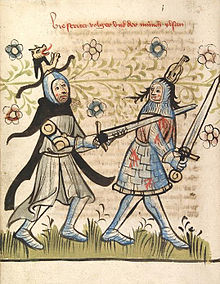Surcoat


A surcoat, or surcote, was an outer garment commonly worn in the Middle Ages by both men and women. It can either refer to a coat worn over other garments or the outer garment of a person. The name derives from French meaning "over the cotta", a long, wide coat reaching down to the feet without sleeves.[1]
From about the 12th century, knights wore long and flowing surcoats over their armour, which were frequently emblazoned with the arms of the wearer. They usually extended to about mid-calf, had slits in the bottom front and back, and were sleeved or sleeveless. Historians believe that the practice of wearing white surcoats was picked up from the Turks during the crusades, and their purpose was to reflect heat, thus protecting mail from direct sun, which heated the mail and the soldier inside. The surcoat also serves in areas of poor weather to keep the rain and muck of battle away from the easily corroded maille-links. The surcoat displayed the device of a knight (origin of "coat of arms") which identified him, which, with the rise of the great helm in the late 12th century and early 13th century, became more and more crucial. Some historians even cite this as a reason behind the spread of heraldry across medieval Europe. During the 13th century, knights also began to add plates of armour to the surcoat, the armored surcoat later became the medieval coat of plates. In the early fourteenth century, the front of the knight's surcoat was shortened, so it was long at the back, but knee-length at the front. This allowed for easier movement and also eliminated the danger of the knight getting his spurs caught up in the long surcoat. By the mid-fourteenth century the long surcoat was replaced with the "Jupon" (or "Gipon"), a much shorter garment, which was often padded for extra protection.[2]
In the 15th century, once suits of plate armour became common, the surcoat was phased out of use. The period in the history of armour development in which surcoats first generally become rare is referred to as the "surcoatless period" (1420-1485).
See also
Footnotes
- ^ Nunn, pp. 14, 23, 24, 28
- ^ Farr, E. (1873). The National History of England. Vol. 1. London & Glasgow: William Collins, Sons & Company. Retrieved 2011-04-06.
{{cite book}}: Unknown parameter|coauthors=ignored (|author=suggested) (help)
Sources
- Nunn, Joan, Fashion in costume, 1200-2000, New Amsterdam Books, 2000, ISBN 1-56663-279-X
